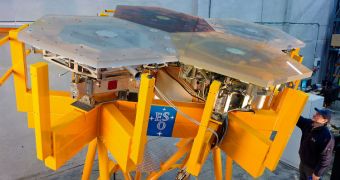When completed – most likely in the next decade – the European Extremely Large Telescope (E-ELT) will be the biggest observatory ever. Before it can be assembled though, researchers need to create models of its components. Such models, covering a section of its main mirror, have recently been put together.
Investigators at the Garching facility, which the European Southern Observatory (ESO) operates in Germany, built a series of four main mirror segments, which are identical in size to the ones that will go on the massive observatory.
The difference is that experts now have access to 4 of these segments, whereas the finished telescope's main mirror will contain 798 segments. The E-ELT will have an aperture of 39.3 meters (128.93 feet).
It will operate in optical to mid-infrared wavelengths, and will be housed in a dome to be constructed atop Cerro Armazones, in Chile. Its Nasmyth-mount design will enable the addition of heavy spectrographs and other similar instruments. E-ELT will have a 10-arcminute field of view.
This year will mark an important milestone in the efforts to construct the telescope. ESO reports that 2012 will see the groundbreaking ceremony finally taking place in the Chilean Andes.
But before the installation is put together, experts need to ensure that all components function well with each other. This is why the Garching facility was commissioned to create the four full-scale models of E-ELT main mirror segments. Each of them is 1.45 meters (4.75 feet) across.
ESO experts are especially interested in learning how these hexagonal mirrors and their support structures interact. Putting this system together is made even more difficult by the fact that the E-ELT will be outfitted with an adaptive optics light-correction system.
What this system will do is basically compensate for the disturbances light experiences as it passes through the atmosphere. In effect, image will appear as if the telescope is seeing them from space. However, AO requires experts to install motors on each of the mirror segments, making their support structure quite bulky.
“Two of the four segments can be tilted by position actuators to adjust the shape of the mirror. The actuators move and support the segments – each with a weight of 245 kg [540 pounds] – with nanometer precision,” an ESO press release reports.
“Shape actuators enable minute deformations of each segment to correct for tiny errors in the surface shape, caused by inevitable variations in manufacturing and assembly, as well as mechanical stresses or temperature shifts,” the document adds.
“Edge sensors constantly measure the relative positions of each segment and its neighbors to ensure that the overall surface shape remains unchanged when the whole assembly is tilted or disturbed by external factors such as wind, temperature changes or vibrations,” the ESO statement concludes.

 14 DAY TRIAL //
14 DAY TRIAL //